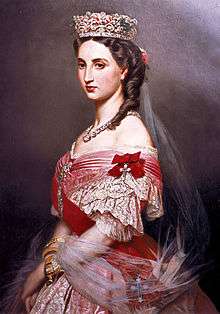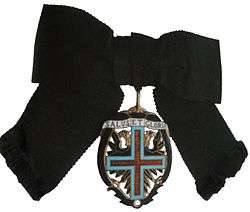Mexican Imperial Orders
There were three Imperial Orders of the Mexican Empire, created to reward Heads of state and prominent people during the two periods of the Mexican Empire – the Imperial Order of Guadalupe (Spanish: Orden Imperial de Guadalupe), the Imperial Order of the Mexican Eagle (Spanish: Orden Imperial del Águila Mexicana), and the Imperial Order of Saint Charles (Spanish: Orden Imperial de San Carlos).
pano.jpg)
Imperial Order of Guadalupe

_-_ribbon_bar.gif)
The third and last period of the Order began on June 30, 1863, before the arrival of Maximilian I, by decree of the Provisional Imperial Government. Maximilian I modified the statutes of the Order for the last time on April 10, 1865, renaming the order "Imperial" (instead of "National") and divided it into four ranks, each with civilian and military divisions:
- Grand Cross, limited to 30 recipients.
- Grand Officer, limited to 100 recipients.
- Commander, limited to 200 recipients.
- Knight, limited to 500 recipients.
Among those who received this honour were Vicente Guerrero, Agustín de Iturbide, Alexander von Humboldt, Wilhelm von Tegetthoff, and Leopold I of Belgium.
Imperial Order of the Mexican Eagle

- Grand Cross
- Grand Officer
- Commander
- Officer
- Knight
The award survives partially (in name at least) in the modern Mexican Order of the Aztec Eagle.
Imperial Order of Saint Charles
.jpg)
_-_ribbon_bar.gif)
Grand Crosses

Some Ladies Grand Cross of the Order of Saint Charles include:[1]
- Elizabeth of Bavaria, Empress of Austria and Queen of Hungary (Sissi), consort of Franz Joseph I of Austria, Charlotte's sister-in-law
- Marie Henriette of Austria, Queen of Belgium, consort of Leopold II of Belgium, Charlotte's sister-in-law
- Maria Amalia of Naples and Sicily, former Queen of France, consort of Louis Philippe I, Charlotte's maternal grandmother
- Queen Isabella II of Spain
- Amélie of Leuchtenberg, Empress Dowager of Brazil, 2nd consort of Pedro I of Brazil
- Teresa Cristina of the Two Sicilies, Empress of Brazil, consort of Pedro II of Brazil
- Princess Leopoldina of Brazil
- Louise of Hesse-Kassel, Queen of Denmark, consort of Christian IX of Denmark
- Eugenia María de Montijo de Guzmán, Empress of France, consort of Napoleon III
- María Manuela Kirkpatrick de Closebrun, Countess of Montijo y de Teba, Empress Eugénie's mother
- Princess Anne Murat, Duchess of Mouchy, daughter of Prince Lucien Murat
- Maria Pia of Savoy, Queen of Portugal, consort of Luís I of Portugal
- Augusta of Saxe-Weimar-Eisenach, Queen de Prussia, consort of future William I, German Emperor
- Victoria, Princess Royal, Royal Princess of Prussia, consort of future Frederick III, German Emperor
- Maria Feodorovna (Dagmar of Denmark), Empress of Russia, consort of Alexander III of Russia
- Amalie Auguste of Bavaria, Queen of Saxony, consort of John of Saxony
- Josephine of Leuchtenberg, Queen Mother of Sweden & Norway, consort of Oscar I of Sweden
- Louise of the Netherlands, Queen of Sweden & Norway, consort of Charles XV of Sweden
- Gertrudis Enríquez y Sequera de Suárez de Peredo Hurtado de Mendoza, Countess del Valle de Orizaba,[2] her Chamberlain's wife.
See also
References
Sources
- Encuentra.com: The Popes and the Virgin of Guadalupe - in Spanish
- This article draws heavily on the corresponding article in the Spanish-language Wikipedia, which was accessed in the version of August 21, 2005.
